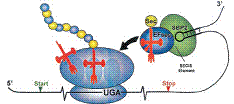Biochemistry, Department of

Vadim Gladyshev Publications
Document Type
Article
Date of this Version
May 2001
Abstract
Mammalian selenocysteine-containing proteins characterized with respect to function are involved in redox processes and exhibit distinct expression patterns and cellular locations. A recently identified 15-kDa selenoprotein (Sep15) has no homology to previously characterized proteins, and its function is not known. Here we report the intracellular localization and identification of a binding partner for this selenoprotein which implicate Sep15 in the regulation of protein folding. The native Sep15 isolated from rat prostate and mouse liver occurred in a complex with a 150-kDa protein. The latter protein was identified as UDP-glucose:glycoprotein glucosyltransferase (UGTR), the endoplasmic reticulum (ER)-resident protein, which was previously shown to be involved in the quality control of protein folding.UGTRfunctions by glucosylating misfolded proteins, retaining them in the ER until they are correctly folded or transferring them to degradation pathways. To determine the intracellular localization of Sep15, we expressed a green fluorescent protein-Sep15 fusion protein in CV-1 cells, and this protein was localized to the ER and possibly other perinuclear compartments. We determined that Sep15 contained the N-terminal signal peptide that was essential for translocation and that it was cleaved in the mature protein. However, C-terminal sequences of Sep15 were not involved in trafficking and retention of Sep15. The data suggest that the association between Sep15 and UGTR is responsible for maintaining the selenoprotein in the ER. This report provides the first example of the ER-resident selenoprotein and suggests a possible role of the trace element selenium in the quality control of protein folding.


Comments
Published in THE JOURNAL OF BIOLOGICAL CHEMISTRY, Vol. 276, No. 18, Issue of May 4, pp. 15330–15336, 2001.